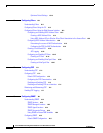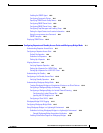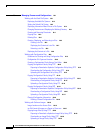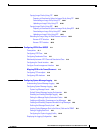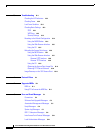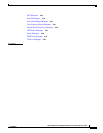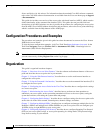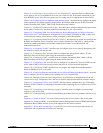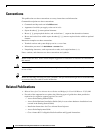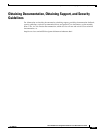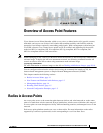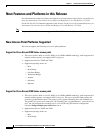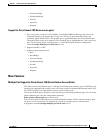
-xx
Cisco IOS Software Configuration Guide for Cisco Aironet Access Points
OL-30644-01
Configuration Procedures and Examples
Points and Bridges for this release. For information about the standard Cisco IOS software commands,
refer to the Cisco IOS software documentation set available from the Cisco.com home page at Support
> Documentation.
This guide also includes an overview of the access point web-based interface (APWI), which contains
all the functionality of the command-line interface (CLI). This guide does not provide field-level
descriptions of the APWI windows nor does it provide the procedures for configuring the access point
from the APWI. For all APWI window descriptions and procedures, refer to the access point online help,
which is available from the Help buttons on the APWI pages.
Configuration Procedures and Examples
The procedures and examples given in this guide have been documented as seen on the Cisco Aironet
3600 Series Access Points.
To view the latest configuration examples, visit Cisco Tech Zone(https://techzone.cisco.com). In the
Tech Zone Navigator, browse to Wireless LAN > Autonomous APs (IOS) - Knowledge base for
Autonomous (IOS) Wireless Deployments.
Note You need to have an account on Cisco.com to access Cisco Tech Zone. If you do not have an account,
you can create one by clicking Register Now on the Log In page.
Organization
This guide is organized into these chapters:
Chapter 1, “Overview of Access Point Features,” lists the software and hardware features of the access
point and describes the access point role in your network.
Chapter 2, “Using the Web-Browser Interface,” describes how to use the web-browser interface to
configure the access point.
Chapter 3, “Using the Command-Line Interface,” describes how to use the command-line interface (CLI)
to configure the access point.
Chapter 4, “Configuring the Access Point for the First Time,”describes how to configure basic settings
on a new access point.
Chapter 5, “Administrating the Access Point,” describes how to perform one-time operations to
administer your access point, such as preventing unauthorized access to the access point, setting the
system date and time, and setting the system name and prompt.
Chapter 6, “Configuring Radio Settings,” describes how to configure settings for the access point radio
such as the role in the radio network, transmit power, channel settings, and others.
Chapter 7, “Configuring Multiple SSIDs,” describes how to configure and manage multiple Service Set
Identifiers (SSIDs) and multiple basic SSIDs (BSSIDs) on your access point. You can configure up to
16 SSIDs and up to eight BSSIDs on your access point.
Chapter 8, “Configuring Spanning Tree Protocol,”describes how to configure Spanning Tree Protocol
(STP) on your access point, bridge, or access point operating in a bridge mode. STP prevents bridge
loops from occurring in your network.



